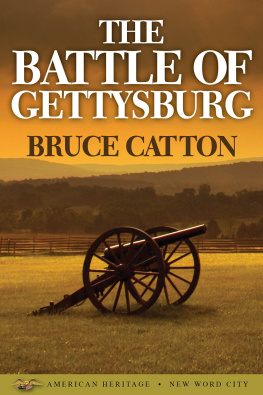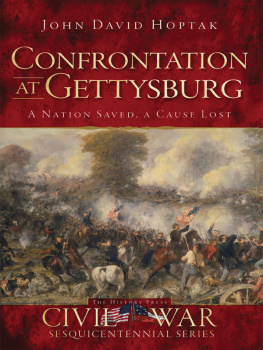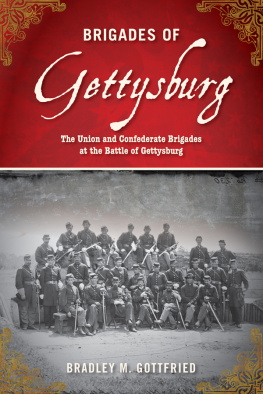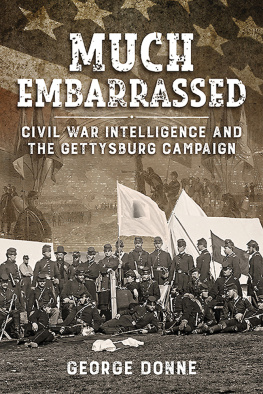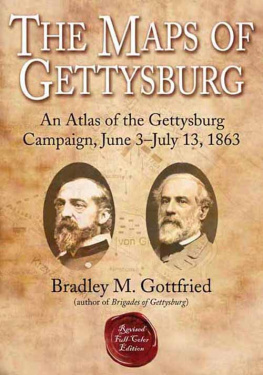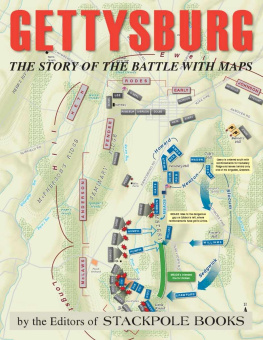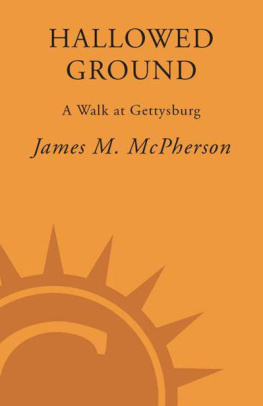GettysburgThe First Day
CIVIL WAR AMERICA
Gary W. Gallagher, editor
2001 The University of North Carolina Press
All rights reserved
Manufactured in the United States of America
Set in New Baskerville and Clarendon types
by Keystone Typesetting, Inc.
The paper in this book meets the guidelines for permanence
and durability of the Committee on Production Guidelines for
Book Longevity of the Council on Library Resources.
Library of Congress Cataloging-in-Publication Data
Pfanz, Harry W. (Harry Willcox), 1921
Gettysburg, the first day / by Harry W. Pfanz.
p. cm. (Civil War America)
Includes bibliographical references (p. ) and index.
ISBN 0-8078-2624-3 (cloth: alk. paper)
1. Gettysburg (Pa.), Battle of, 1863. I. Title. II. Series.
E475.53.P479 2001
973.7'349dc21 00-048927
05 04 03 02 01 5 4 3 2 1
For
Sarah, John, and Matthew Pfanz
and
Elizabeth and Katherine Ake
CONTENTS
MAPS
2.1 Gettysburg Campaign, 30 June1 July
5.1 Gettysburg Area
7.1 Davis Attacks Cutler
8.1 McPherson Woods, Morning
9.1 Action at the Railroad Cut, Morning
12.1 Oak Hill and Oak Ridge, Early Afternoon
13.1 Rodes's Division Attacks
14.1 Rodes Smashes Robinson's Salient
15.1 Daniel's First Attack
15.2 Daniel's Second Attack
15.3 Daniel's Third Attack
17.1 Early Attacks the Eleventh Corps's Right
19.1 The Brickyard Fight
20.1 Heth's Afternoon Attack
21.1 Pender's Division Attacks
24.1 Artillery Positions, Cemetery Hill
ILLUSTRATIONS
Gen. Robert E. Lee
Lt. Gen. Richard S. Ewell
Maj. Gen. George G. Meade
Brig. Gen. John Buford and staff
Col. William Gamble and staff
Memorial, 17th Pennsylvania Cavalry
Maj. Gen. John F. Reynolds
Lt. John H. Calef
Chambersburg Pike (postbattle), McPherson Ridge to Herr Ridge
Brig. Gen. Joseph R. Davis
Brig. Gen. Lysander Cutler
Alfred R. Waud, Death of Reynolds, Gettysburg
Brig. Gen. James S. Wadsworth
McPherson farm buildings from the east (postbattle)
Brig. Gen. James J. Archer
McPherson Woods, site of Reynolds's death
Lt. Col. Rufus R. Dawes
Center railroad cut from the east in 2000
Lt. Gen. Ambrose P. Hill
Brig. Gen. James J. Pettigrew
Maj. Gen. Abner Doubleday
Col. Roy Stone
Maj. Gen. Oliver Otis Howard
Maj. Gen. Jubal A. Early
Maj. Gen. Robert Rodes
Brig. Gen. George Doles
Brig. Gen. Henry Baxter
Brig. Gen. Junius Daniel
Brig. Gen. John C. Robinson
Brig. Gen. Stephen D. Ramseur
Color Sgt. Samuel L. Peiffer
The 143d Pennsylvania's memorial, Sgt. Benjamin H. Crippen defies the Rebel foe
Maj. Gen. Carl Schurz
Brig. Gen. Alexander Schimmelfennig
Brig. Gen. Francis Barlow
Brig. Gen. Adelbert Ames
Lt. Col. Douglas Fowler
Lieutenant Bayard Wilkeson holding his battery... to its work on Blocher's Knoll
Col. Wladimir Krzyzanowski
Brig. Gen. John B. Gordon
Pvt. Reuben Ruch
Col. Francis Mahler
Col. Charles R. Coster
Pvt. Charles Comes, 8th Louisiana Infantry, killed 1 July
Maj. Gen. Henry Heth
Col. Henry K. Burgwyn Jr.
Capt. Romulus M. Tuttle
Maj. Gen. William D. Pender
The Lutheran seminary
Col. Abner Perrin
Cemetery gatehouse and Stewart's battery's lunettes
Maj. Gen. Winfield S. Hancock
Color Sgt. Henry G. Brehm
PREFACE
This is an account of the battle of 1 July 1863 at Gettysburg and of certain relevant events and decisions immediately preceding it. The battle was a meeting engagement; neither Gen. Robert E. Lee, commander of the Confederate Army of Northern Virginia, nor Maj. Gen. George G. Meade, commander of the Federal Army of the Potomac, planned to give battle at Gettysburg. Events and subordinate commanders took measures that made Gettysburg the battle site. They included Lt. Gen. Ambrose Powell Hill, commander of Lee's Third Army Corps; Maj. Gen. Henry Heth, one of Hill's division commanders; Brig. Gen. John Buford, commander of the First Division of the Army of the Potomac's Cavalry Corps; and Maj. Gen. John F. Reynolds, the commander of that army's temporary left wing.
The battle commenced about 8:00 A.M. approximately three miles west of the town when Union cavalry videttes opened fire on a Confederate column advancing on Gettysburg. There was skirmishing as the horsemen fell back toward Gettysburg and their support. Close to 10:00 A.M., as cavalry units formed on the low ridges west of the town, infantry of the Union First Corps reached the field. There was a sharp but brief fight between two Confederate and two Union infantry brigades, and the Confederates fell back.
There followed a lull of some three hours punctuated by the crack of skirmishers rifles and occasional cannon shots, as strong reinforcements reached the area. The Union First and Eleventh Corps took defensive positions west and north of Gettysburg, and arriving Confederates from Hill's and Lt. Gen. Richard S. Ewell's corps formed opposite them. Full-scale fighting resumed about midafternoon as the Confederates attacked first from the north and then from the west. There was a short but violent fight, and soon after 4:00 P.M. the two Union corps retreated through the town south to Cemetery Hill. There they rallied, and the Confederates did not continue their attack. The remainder of both armies reached the Gettysburg area that night and on the following day, setting the stage for the battles of 2 and 3 July.
The battle has spawned a number of suppositions. One is that a battle at Gettysburg was inevitable because of the concentration of roads there. Another proposition holds that Union cavalrymen, by hard fighting, delayed the Confederates arrival at Gettysburg until Union infantry was at hand. Many people believe that a Confederate sharpshooter shot General Reynolds. One of the greatest clichs is that Union forces were defeated on 1 July because of the poor performance of the Eleventh Corps. In addition, it has been accepted by many that only Lt. Gen. Richard S. Ewell's vacillation and his failure to press an attack against the Union forces rallying on Cemetery Hill prevented the Confederates from achieving a complete victory. I address these and other matters in the following text.
Information on battles is usually spotty and less than we would like. This is true of the battle of 1 July. Although the outlines of the day are plain enough, some details escape us. For instance, we do not know where on Oak Hill O'Neal's and Ramseur's brigades formed for their attacks and the exact locations there of the positions of the batteries that supported Rodes's division. On the Union side our knowledge of locations of the regiments of Schurz's division and the positions of Dilger's and Wheeler's batteries are equally vague. We may well wonder, too, how so many of the regiments of Baxter's brigade fitted into the limited front on Oak Ridge at the time of Iverson's assault, and just where Cutler's and Baxter's brigades were on Oak Ridge before they retreated into the town. The lack of such information makes for difficult plotting of the battle on maps.
Here it may be well for me to note that we cannot be certain about some terrain features on the field. For instance, was the orchard on Oak Hill by the Mummasburg Road there during the battle and, if so, were its trees large enough to affect the posting of batteries on the hill? If so, how much? None of the men who fought there mentioned it. Some of the prominent terrain features such as Sheads's Woods or the Springs Hotel Woods did not have names known to the combatants or to us today. In such cases I have identified these features by using names that were obviously applied after the battle or might not have been in common use at all. The name Herbst Woods, applied now because a John Herbst owned it at the time of the battle, was commonly called McPherson Woods by soldiers and veterans. Because of this, I have opted not to use the present-day Herbst designation.
Next page

